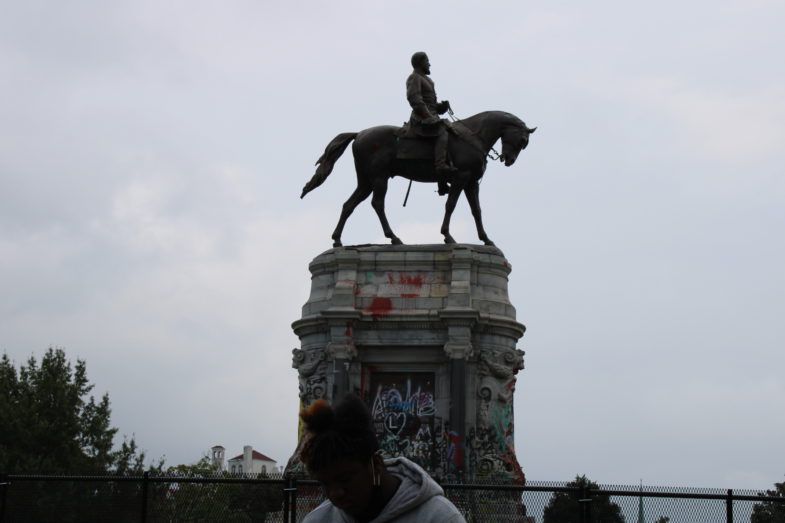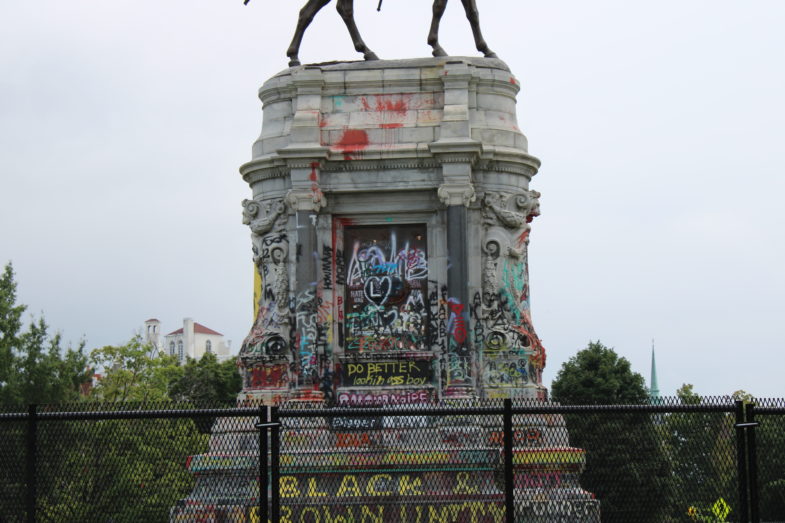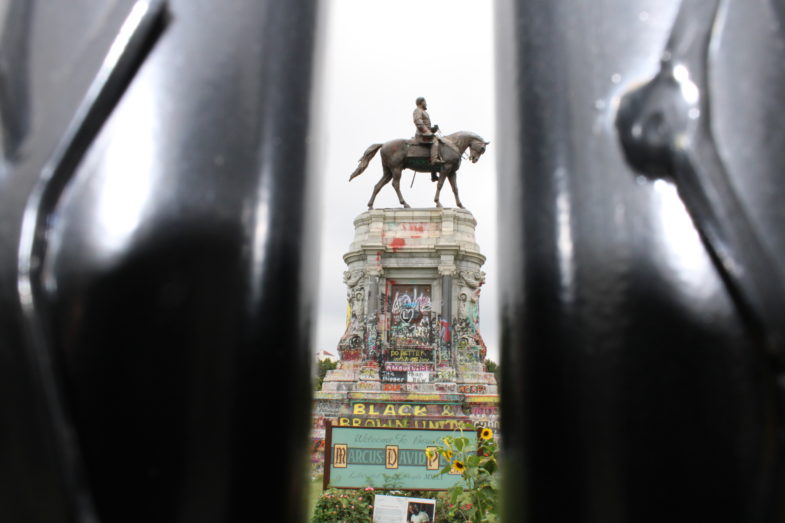The Monument
[Calm yet intriguing music]
[Video opens with multiple photos of the Robert E. Lee monument in Richmond. It starts with just the street but as the pictures progress, it moves to show the fencing, the bottom of the monument, then a photo of the monument centered between a hole in the fence, zooming in. to get a closer look.]
TEXT: These are pictures of the Robert E. Lee monument in Richmond, Virginia, taken in July.
[Cut to a clip of the statue being removed.]
TEXT: And this is the monument being removed in September.
[Fade out of calm music, fade into upbeat and tense music]
TEXT: What changed?
TEXT: Who changed it?
TEXT: Will it change again?
TEXT: This is
[A picture of the monument between fence holes is displayed. As it zooms in, the title “The Monument” appears on screen.]
[Fade out of upbeat and tense music, fade into happier background music]
[MAKAYLA, shortened to “MAK,” sitting at a table. Unless otherwise mentioned in the script, any time she speaks the video will be of her sitting at the table talking.]
MAK 00:01:11 Hi, I’m Makayla. I’m a Richmond Native but grew up in Chester. [0:05]
[JAKE, sitting at a table. Unless otherwise mentioned in the script, any time he speaks the video will be of him sitting at the table talking.]
JAKE 00:01:19 Hi, my name is Jake. [0:02]
[XAVIER sitting at a table. Unless otherwise mentioned in the script, any time he speaks the video will be of him sitting at the table talking.]
XAVIER 0:01:25 Hi my name is Xavier, I’m a local to the area. [0:04]
[CONNOR, sitting at a table. Unless otherwise mentioned in the script, any time he speaks the video will be of him sitting at the table talking.]
CONNOR 0:01:34 My name is Connor. I am originally from Richmond, Virginia. I was at the protests as a protester. [0:07]
JAKE 00:01:21 I attended the BLM protest in Richmond. [0:04]
MAK 00:01:18 And yes, I’m a protester. [0:01]
[A picture of all four interviewees—each of them sitting at the desk or table—taken from their interview footage. While the narration plays, there is muted video of each of the 4 interviewees speaking.]
NARRATOR: These people have close ties to the monument. 3 are Richmond locals, and 3 out of 4 of them protested. They each decided to talk about their experience last summer, and their feelings toward the controversial statue.
[Videos of people walking around and protesting in Richmond at night.]
XAVIER 00:04:11 During the 2020 protests, it was a lot going on throughout the street, there was a lot of protesting, a lot of police and a lot of boarding up a lot of cutting off areas. It was a lot of chaos, to say the least.
But I felt like it was very much needed to just...for us as a community to move forward, I would say. [0:24]
[Videos of people protesting during the day. They are walking down the road, then there is a bird’s eye view of the statue, and a person giving a speech on a podium.]
MAK 00:08:51 It was beautiful. Honestly, it was a lot of unity. Everybody was very kind, everybody was there for the same cause it didn't matter what race, religion,creed you come from. Everybody there wanted their voices to be heard. I mean, there was a lot of chanting, there were a lot of signs. There were a lot of speakers. Oh, it was honestly, something very beautiful and I'm very appreciative to be able to have been there and seen it. [0:27]
Video: https://www.cbsnews.com/news/george-floyd-black-lives-matter-impact/
[Photos of signs being held up for Trayvon Martin, Sandra Bland, and Michael Brown. More videos of national protests, not just those in Richmond.]
JAKE 00:16:02 To me just seeing protests happening in, you know, every state in the country and all across the world for black lives. I just thought it was something that I needed to get involved in. Because not often do we get grassroots movements like this that, you know, gain traction and gain a breaking recognition nationwide. [0:25]
[A photo of people protesting with their fists up and holding signs that protest police brutality.]
CONNOR 00:22:07 I've seen police brutality firsthand. And I grew up around here. So it really meant a lot to me. I knew about the historical context behind it and what it represented, and I wanted to be there for that. [0:16]
XAVIER 00:12:30 I wasn’t really into, like the stuff that I am into now, ‘cause I was kind of young and dumb,don’t get me wrong. But I’d drive by like “ Oh my gosh, Mom, that's so cool. That's like so big.” And like, now I see it and just like, take the damn thing down. [0:15]
[A photo of the statue, zooming in on the graffiti.]
NARRATOR: So what is the history behind the monument? Why is it so important that there’s graffiti on it now?
[cut to various photos of Robert E. Lee, and a person today holding a Confederate flag at the base of the Robert E. Lee statue today.]
NARRATOR: This monument is dedicated to Robert E. Lee, a Confederate general from Virginia. According to the Atlantic, he was even known as the “Christian Warrior,” for his devotion to the Confederacy and their Christian values. For those who erected it, the statue was meant to represent the ideal Confederate man: devoted to both his faith and his country. But today, the 21 foot tall statue is a reminder of Virginia’s darkest history.
[Cut back to each interviewee speaking.]
JAKE 00:17:55 You know, for these communities in Richmond, it's been an eyesore on the city for so long.[0:03]
XAVER 00:04:36 Seeing how big it was..was kind of... what's the word? Intimidating. [0:06]
[Cuts to different articles that say stuff like “massive,” “12-ton,” etc. to show how it is described as large in news articles.]
MAK 00:08:36 It was very, it's very big, it's very grandiose, you know, it’s right there in Richmond in the heart of Richmond where, you know, there are a lot of African American and black people. [0:10]
XAVIER 00:04:43 Seeing something that huge, cause it stands for something that is so wrong...it's kind of scary because it shows how much you know the community cares about it. And then sort of like stuff like that like that's like about black history, like museums and stuff. Those are like not that huge but you have this big statue out there that just supports racism basically. [0:22]
MAK 00:10:02 We don't see a whole bunch of statues of you know, Rosa Parks and Martin Luther King's and all these different, you know, Malcolm X and all these different black advocates everywhere. So why should we constantly look at those who oppressed us, in a sense you know? [0:14]
[As the narrator speaks, there are multiple videos of protestors at the monument, chanting and holding signs.]
NARRATOR: As the monument changed, so did their opinions on the removal of the monument. Protestors, who fought to take the statue down, now wanted it to remain.
CONNOR 00:23:55 I believe now it represents something completely different with the graffiti on it. [0:07]
[Photos of people setting up tables at the monument, playing basketball, kids taking pictures and a student taking their graduation photos there.]
JAKE 00:16:36 I absolutely love the space. Now, I know the city recently hasn't let people go too close to it. But the way that it has been, I guess there's been artwork that's done around it, and on it. And...and just all the changes that the community has made to the space, I just think that it's truly a symbol of like, what America can be, instead of what it currently is. [0:28]
CONNOR 00:24:09 I think it is now actually a huge piece of history, especially in Virginia.
Considering how important those protests were. [0:11]
MAK 00:15:16 Just seeing what has gone on with the Robert E. Lee monument..it's beautiful. It just shows what can happen when we all come together, it shows that history, you know, just remakes itself. [0:14]
JAKE 00:18:14 I really, really do enjoy it now. Every time I go to Richmond, I make sure that I'm like, Hey, can we drive by? I just want to see it. So to me the statue is more alive now than it had ever been. [0:13]
[A video of protestors changing at the base of the statue again. Also various pictures of the statue including a man holding up his kid, people playing chess, and overall feeling relaxed at the statue.]
NARRATOR: The monument transformed from a symbol of hate to a symbol of black empowerment. Their change in heart about the monument can’t only be credited to graffiti. To figure out why, Dr. Lyndsey Beutin, who studies how the memory of slavery is used in contemporary political movements, and also was active in the fight to remove Confederate statues in Charlottesville, defined the term “confront in place,” which explains the phenomenon.
[A video from a news segment, when the monument was first splattered with red paint. Then there is a muted video of Ralph Northam talking about the statue, and another video of a protestor speaking about the monument with people spray painting it in the background.]
BEUTIN 00:00:00 So the idea behind confronting Confederate monuments in place is that you don’t completely remove the monument, but you use the monument to contextualize the history of the Lost Cause as white supremacist propaganda. Confront in place is a concept and a strategy that relies on the city to sanction the process. So the city has to agree how it will be recontextualized and that can be a pretty fraught negotiation. What we see in Richmond though is something different, where community members took it upon themselves to resignify the monument with spray paint and racial justice messages, which eventually led to the city removing Lee, but keeping the graffitied pedestal, at least as it stands so far. [0:50]
[Photos of the monument being removed.]
NARRATOR: With Robert E. Lee removed, the pedestal takes on a new meaning. It’s incredible to think that this Christian Confederate symbol can now be a beacon of hope for every race or religious group.
XAVIER 00:01:42 We have to show them what we are as a community as black, queer, LGBTQ plus people of color. They wronged us for so many years. So us taking down this monument and beating it and making it ours... [snaps]...perfect. [0:18]
[Fade to black.]
[Black screen with white text.]
[Ending Credits]







